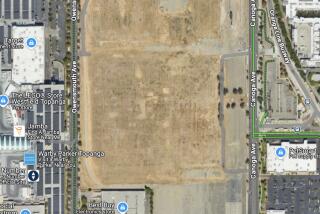It Was Just Dust, Town Thought
- Share via
HERCULANEUM, Mo. — They saw the dust, of course. It was hard to miss. It settled on their swing sets, their picnic tables, their windowsills--a film of dark gray grime. Wipe it away one day and it would be back the next.
Residents didn’t think much of it. They do now.
Now, many mothers forbid their children to play outside. The school bus picks up some students at their homes so they don’t have to wait on the corner. Parts of several streets are closed to pedestrians. Danger, the signs warn. Too much dust.
After a century in the shadow of the nation’s largest lead smelter, this modest little river town has awakened with a jolt. Residents learned last month that the dust they have brushed off as a nuisance all these years may have poisoned their homes, their playgrounds--and their children.
A typical patch of soil in Missouri may have 200 parts per million of lead. The federal government considers a residential yard safe with up to 400 parts per million.
The dust along some Herculaneum streets has registered 300,000 parts per million.
Denise Jordan-Izaguirre, who tracks toxic substances for a federal registry, said she has never seen lead contamination that bad. Not even at the mines.
Other readings around the community were nearly as alarming. At a neighborhood park, monitors found soil with 30,000 parts per million. Several yards checked in at more than eight times the safety standard. The high school football field was contaminated. So was part of an elementary school playground.
An Unknown Number of ‘Leaded’ Children
The state declared an “imminent and substantial” threat to public health in Herculaneum.
“Sprinkled over the grass is gray dust,” Jordan-Izaguirre said. “That gray dust is lead.”
And lead is poisonous, especially for young children. Those who absorb too much as they are developing can suffer side effects ranging from stomachaches to learning disabilities to stunted intelligence.
Locals now have a name for such children. They call them “leaded.” No one knows for sure how many leaded children there are in Herculaneum, a slightly frayed town of 2,800 on the Mississippi River.
The Doe Run Co., which operates the smelter, has conducted several community health screenings over the decades. The most recent one, held last year, tested nearly every child under age 6; 15% had too much lead in their blood. That’s almost four times the national average. It’s not as bad, however, as the numbers just up the river in St. Louis, where as many as 1 in 4 children are poisoned by the peeling lead paint in their homes.
Compared with such urban calamities, “the risk [in Herculaneum] is relatively low,” said Dan Vornberg, vice president of environmental affairs for Doe Run.
But that is little consolation to frantic parents.
“It’s absolutely frightening,” said Leslie Warden, a town alderman and mother of a teenage son.
Warden tortures herself imagining all that lead dust may have cost her family. Can she blame it for her son’s attention deficit disorder? For her inability to conceive again?
“It puts a knot in your stomach and brings tears to your eyes,” she said. “There’s just no words.”
Her sister-in-law Robyn Warden has two of the town’s most leaded children, toddler Grace and preschooler Aaron. Doctors consider a blood-lead level of 10 micrograms per deciliter worrisome. Gracie’s level has been as high as 44. Aaron’s topped out at 26. The children seem to be developing normally, but Aaron vomited every morning for years, and Gracie had constant stomach pain.
Until moving out of town over the summer, the family lived just two blocks from the Doe Run plant. Dozens of families do. The smelter squats on the hem of a neighborhood. Its 24-acre slag pile is there too; kids play and race dirt bikes on the mounds of contaminated waste.
With its bulky silhouette of pipes and furnaces--and the 550-foot smokestack that towers above all else--the smelter dominates the physical landscape. It also dominates the political one. Doe Run is the only industrial plant in Herculaneum. And “Herky” long has been considered a company town.
Doe Run employs 350 people here. Even more important than the jobs are the taxes; former Mayor Tom Griffith estimated that the company funds 25% of the municipal budget. It pitches in for extra needs too, such as street paving.
While residents appreciate Doe Run’s money, they long have griped about its emissions. Most of the complaints, however, dealt with the occasional belches of sulfur dioxide from the smokestack that blistered the paint on cars and choked kids on the playground.
Doe Run got a handle on the sulfur problem several years ago. The dust, on the other hand, has been a constant. Residents just didn’t know it was a threat.
It did not seem as noxious as the sulfur. And many folks thought they were taking care of any danger by vigilant mopping, dusting and vacuuming. They did not realize that the lead dust would settle deep in the fibers of shag carpets or cling to the tops of ceiling fans. They did not realize it was in the dirt their kids clawed through on bug hunts in the backyard.
Government monitors, however, knew the lead was out there. Herculaneum has never attained compliance with clean-air standards, and state and federal agencies have been working with Doe Run for decades to curb pollution. The company has complied with every directive, spending more than $50 million to slash lead emissions from 850 tons a year in 1980 to fewer than 60 tons a year today.
Regulators Call for Lead Study Recently
But regulators never thought to request a study of the environmental and health effects of all that lead. They ordered such a study only recently, after finding contamination in a nearby creek.
“I would love to say we were out doing this 20 years ago, but we obviously weren’t,” said Tony Petruska, project manager for the Environmental Protection Agency. “If you’re asking why, I don’t have a good answer.”
Now that they are engaged, regulators have demanded swift action from Doe Run. They have ordered the company to scrub contaminated streets and to use only covered trucks to haul lead concentrate to the smelter. Doe Run has 60 days to test nearly every yard in the community for lead; it already has started scraping away contaminated soil outside several homes.
In the longer term, Doe Run has agreed to $15 million worth of retrofitting to control emissions from the smelter. And the company is negotiating with the EPA over how to handle the open-air waste pile, which is loaded with toxins.
“We’re trying to eliminate the smelter as a risk factor. We want to have zero impact,” Vornberg said. “That’s our obligation.”
State regulators, however, are not satisfied with Doe Run’s efforts. They have spotted several trucks leaving the plant without being washed--and with highly concentrated lead ore clinging to them. If such violations continue, they say, the state could halt all truck traffic at Doe Run, which would effectively shut it down.
As they wait for health officials to pronounce their town safe, parents contort their lives in an effort to keep their kids from harm.
“My son’s feet don’t hit the ground in Herky. I carry him,” said Sarah Schweigert, whose 2-year-old, Griff, has elevated levels of lead in his blood.
Monica Wamble’s two children so far have tested within safe limits. Still, she’s taking no chances. “My kids have not gone outside for five or six weeks now,” she said. “I just spent $50 on crafts to keep them happy inside. It’s horrible. I feel like a prisoner.”
Although other parents clearly share this anguish, the community overall is not raging against Doe Run. Several families have filed a lawsuit. But many others, including the mayor, support the smelter. They think Doe Run is doing its best to clean up. They want the jobs and the taxes to stay in Herculaneum.
“Close that plant, and we could lose our home,” said Sue Griffith, whose husband works there.
The Griffiths raised two daughters in a home just a few blocks from the smelter. They often care for their grandsons there now--Griff and 6-month-old Caleb, who is getting tested for the first time this month. Sue scrubs away the gray dust daily, just as she has since they moved to Herculaneum. She is concerned, of course, about her grandsons’ health.
“But to honestly say it’s all Doe Run’s fault, I can’t do that,” she said. “The EPA and the health department have let us down too. Doe Run did exactly what the agencies told them to do.”
More to Read
Sign up for Essential California
The most important California stories and recommendations in your inbox every morning.
You may occasionally receive promotional content from the Los Angeles Times.










